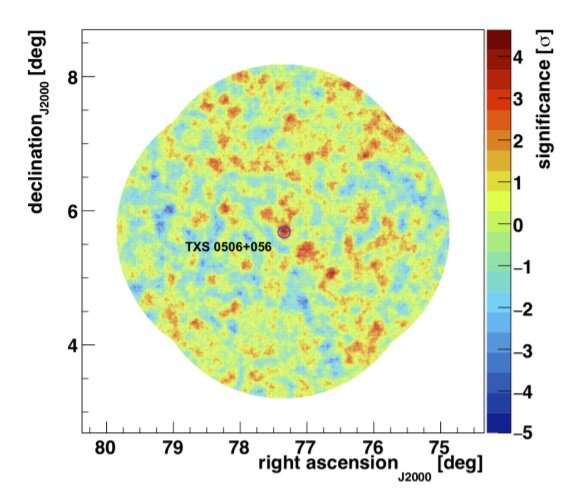August 18, 2021 report
Research examines emission from the blazar TXS 0506+056

Using the Very Energetic Radiation Imaging Telescope Array System (VERITAS), an international team of astronomers has conducted long-term observations of a gamma-ray blazar known as TXS 0506+056. Results of the observational campaign, published August 11 on arXiv.org, deliver essential information regarding the emission from this source.
Blazars are very compact quasars associated with supermassive black holes at the centers of active, giant elliptical galaxies. Based on their optical emission properties, astronomers divide blazars into two classes: flat-spectrum radio quasars (FSRQs) that feature prominent and broad optical emission lines, and BL Lacertae objects (BL Lacs), which do not.
In general, blazars belong to a larger group of active galaxies that host active galactic nuclei (AGN), and their characteristic features are relativistic jets pointed almost exactly toward the Earth. However, the detailed mechanisms of ejection and collimation of jets are still poorly understood, and more studies of this phenomenon are required to improve our knowledge on the subject.
At a redshift of 0.3365, TXS 0506+056 is a very high energy blazar of BL Lac type. It is the first known source of high-energy astrophysical neutrinos. Therefore, TXS 0506+056 plays a key role in establishing connections between high-energy neutrinos and astrophysical sources. Studying the time evolution and spectral behavior of this blazar could help us identify the sources of the diffuse neutrino flux and the origin of energetic cosmic rays.
A group of astronomers led by Weidong Jin of the University of Alabama has recently concluded a three-year-long observational campaign of TXS 0506+056, hoping to the shed more light on the emission from this source, which could provide more hints on the connection of this blazar with high-energy neutrinos. For this purpose, they employed VERITAS, which consists of an array of four 12-meter imaging atmospheric Cherenkov telescopes located at the Fred Lawrence Whipple Observatory (FLWO) in southern Arizona.
"VERITAS collected 61 hours of quality-selected observations of TXS 0506+056 from Oct 10, 2018 (MJD 58401) to March 7, 2021 (MJD 59280) with an average zenith angle of 28.8 degrees. Observations were performed using the standard "wobble" observation mode with a 0.5-degree offset in each of four cardinal directions," the researchers wrote in the paper.
VERITAS detected TXS 0506+056 above 190 GeV. The integral flux above an energy threshold of 190 GeV was about 1.34 × 10−12/cm2/s, what corresponds to approximately 0.52 percent of the Crab Nebula flux under the same energy threshold. In general, TXS 0506+056 was found to be in a quiet state from 2018 to 2021.
Moreover, no extended VHE gamma-ray emission was detected by VERITAS. According to the astronomers, this is consistent with a low state of the source during the observed period. The observations also identified clear variability of TXS 0506+056 in optical, X-ray and high-energy gamma-ray bands.
Given that the VERITAS observations of TXS 0506+056 ended a few months ago, the team is still analyzing the collected data. They plan to sum up the results and draw conclusions in the upcoming research paper.
More information: VERITAS follow-up observation of the blazar TXS 0506+056, arXiv:2108.05463 [astro-ph.HE] arxiv.org/abs/2108.05463
© 2021 Science X Network





















